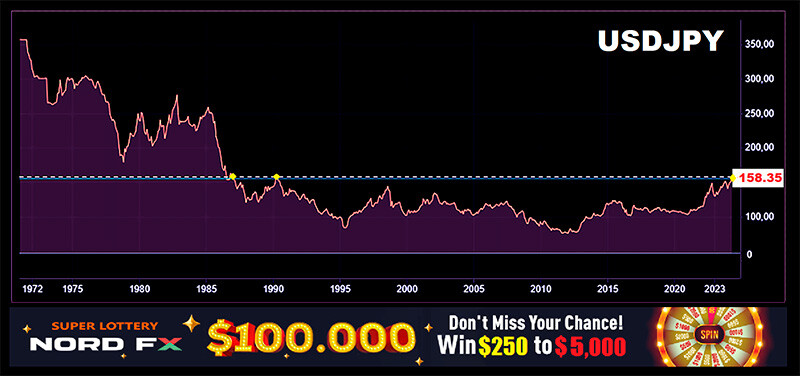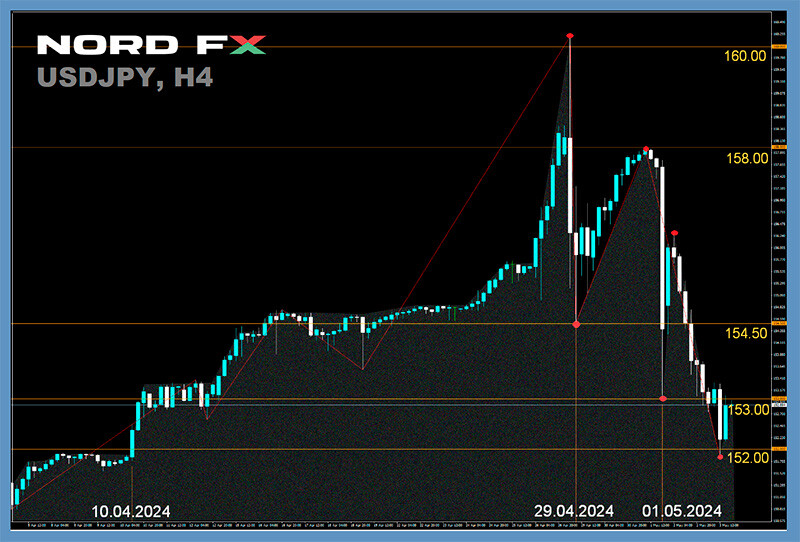Stan NordFX
Member
CryptoNews of the Week

- As expected, on April 20, the fourth halving occurred on the bitcoin network at block #840000. The reward for mining a block has been reduced from 6.25 BTC to 3.125 BTC. It's worth reminding that a halving is the event that reduces the reward for mining new blocks in the bitcoin blockchain by half. This event is encoded in the code of the first cryptocurrency and occurs every 210,000 blocks: until the mining of 21 million coins, presumably in 2040, when the cryptocurrency's emission will end. The fourth halving will ensure that about 95% of all bitcoin emission is mined, with approximately 99% of all coins mined by 2033-2036. Following that, the emission will gradually move towards zero.
Economist and author of the cult book "The Bitcoin Standard," Saifedean Ammous, congratulated the crypto community on the halving. "For the first time in history, people have a form of money whose supply increases by less than 1% per year. [...] The harder the money, the slower its supply increases, the better it retains value in the future, and allows for planning and securing the future," he wrote.
- In the days following the halving, there was no increase in volatility. The price of bitcoin slowly and lazily moved upwards, reaching $66,000 at the time of writing this review. It seems that market participants are frozen in anticipation of who will start buying or selling the main cryptocurrency en masse. However, the founder of venture company Pomp Investments, Anthony Pompliano, believes that within 12-18 months, the coin is likely to first undergo a correction and then rise to $100,000 with chances of reaching $150,000-200,000. "At the moment, the probability of a decrease is quite small. [...] I see no reasons for the rate to drop below $50,000. I think we have already crossed this Rubicon," the entrepreneur believes.
Pompliano recommended buying gold to those looking for capital protection from the fall and the first cryptocurrency to those aiming to increase their purchasing power. "After the previous halving, the first cryptocurrency appreciated eightfold despite volatility. Name any other asset that has shown such high returns over a four-year cycle," he stated, revealing that he invested about half of his personal funds in the first cryptocurrency.
- Analysts at QCP Capital believe that bitcoin optimists will need to wait at least two months before assessing the impact of the recent fourth halving. "The spot price has only grown exponentially 50-100 days after each of the previous three halvings. If this pattern repeats, bitcoin bulls still have weeks to build a larger long position," their report states.
- According to Bitfinex experts, the post-halving supply restriction will stabilize the price of the first cryptocurrency and may contribute to its growth. "The decrease in the pace of bitcoin issuance after halving, which will amount to $30-40 million per day, sharply contrasts with the average daily net inflow of $150 million into spot ETFs. This underscores a significant demand and supply imbalance which may contribute to further price growth," the Bitfinex report indicates.
- A sharp increase in transaction fees on the day of the halving gave Euro Pacific Capital president and "gold bug" Peter Schiff another reason to declare the failure of the first cryptocurrency. On April 20, amid the reduction of the block reward, the average size of fees in the network jumped to a record $128.45. Experts largely linked this to the hype associated with the event around the launch of the Runes protocol.
"The cost of completing a transaction now stands at $128, and its processing takes half an hour. This is another reason why bitcoin cannot function as a digital currency. The costs of using it in this capacity are disproportionately high. This is a failure," Schiff declared. (And he was wrong. Shortly thereafter, the rate dropped nearly 73% to $34.86.)
In the comments, users asked the well-known gold advocate how much it would cost to safely deliver a pound of precious metal around the world. An estimate ranging from $800,000 to $2.3 million depending on the method and speed was voiced. "Remind me, how much does it cost to transport a gold bar to the other end of the world in half an hour?" Jameson Lopp, co-founder of Casa, sarcastically remarked about speed. Schiff responded that it didn't matter since people no longer use precious metal as currency.
- Speaking at a pre-election rally in Michigan, Robert Kennedy Jr. announced to the attendees that if he is elected President of the USA, every American will have the opportunity to review any budget item. "I will move the entire US budget to the blockchain, and we will have 300 million observers over it. If someone spends $16,000 on a toilet seat, everyone will find out!" he declared.
The presidential candidate believes that taxpayers have the right to know exactly what their money is being spent on. According to the politician, blockchain and cryptocurrencies should help the USA remain a leader in innovation and maintain the financial freedom of its citizens. Robert Kennedy Jr. had previously supported bitcoin, stating that the first cryptocurrency takes financial control away from the government and the monopolistic banking system.
- The crypto exchange CoinEx has put up for sale the first satoshi mined after the halving. Buyers can place bids in bitcoins on the auction page. A satoshi is one-hundred-millionth of a bitcoin (0.00000001), and the organisers of the auction hoped that collectors would pay several tens of millions of dollars for this "epic" coin. However, at the time of publication, the highest bid is only 2.5 BTC, which is about $165,000, although this price exceeds the value of one ordinary satoshi by 250 million times. The auction will end on April 26. The exchange will notify participants of the results via a message on the website and by email.
- Fidelity Digital Assets, a leading issuer of one of the spot BTC-ETFs, has revised its mid-term forecast for bitcoin from positive to neutral. The reason for the departure from optimistic views is several worrying trends in the crypto market. Fidelity analysts noted the growing interest in selling from long-term bitcoin hodlers. A large percentage of profitable addresses is currently noted in the report. This means that holders may want to lock in profits and start selling BTC. On the other hand, on-chain data also indicate that small investors continue to accumulate the first cryptocurrency. Since the beginning of the year, the number of addresses holding at least $1,000 in BTC has increased by 20% and reached a new all-time high. "This trend may indicate the growing proliferation of bitcoin and its acceptance among 'average' users," Fidelity notes.

- As expected, on April 20, the fourth halving occurred on the bitcoin network at block #840000. The reward for mining a block has been reduced from 6.25 BTC to 3.125 BTC. It's worth reminding that a halving is the event that reduces the reward for mining new blocks in the bitcoin blockchain by half. This event is encoded in the code of the first cryptocurrency and occurs every 210,000 blocks: until the mining of 21 million coins, presumably in 2040, when the cryptocurrency's emission will end. The fourth halving will ensure that about 95% of all bitcoin emission is mined, with approximately 99% of all coins mined by 2033-2036. Following that, the emission will gradually move towards zero.
Economist and author of the cult book "The Bitcoin Standard," Saifedean Ammous, congratulated the crypto community on the halving. "For the first time in history, people have a form of money whose supply increases by less than 1% per year. [...] The harder the money, the slower its supply increases, the better it retains value in the future, and allows for planning and securing the future," he wrote.
- In the days following the halving, there was no increase in volatility. The price of bitcoin slowly and lazily moved upwards, reaching $66,000 at the time of writing this review. It seems that market participants are frozen in anticipation of who will start buying or selling the main cryptocurrency en masse. However, the founder of venture company Pomp Investments, Anthony Pompliano, believes that within 12-18 months, the coin is likely to first undergo a correction and then rise to $100,000 with chances of reaching $150,000-200,000. "At the moment, the probability of a decrease is quite small. [...] I see no reasons for the rate to drop below $50,000. I think we have already crossed this Rubicon," the entrepreneur believes.
Pompliano recommended buying gold to those looking for capital protection from the fall and the first cryptocurrency to those aiming to increase their purchasing power. "After the previous halving, the first cryptocurrency appreciated eightfold despite volatility. Name any other asset that has shown such high returns over a four-year cycle," he stated, revealing that he invested about half of his personal funds in the first cryptocurrency.
- Analysts at QCP Capital believe that bitcoin optimists will need to wait at least two months before assessing the impact of the recent fourth halving. "The spot price has only grown exponentially 50-100 days after each of the previous three halvings. If this pattern repeats, bitcoin bulls still have weeks to build a larger long position," their report states.
- According to Bitfinex experts, the post-halving supply restriction will stabilize the price of the first cryptocurrency and may contribute to its growth. "The decrease in the pace of bitcoin issuance after halving, which will amount to $30-40 million per day, sharply contrasts with the average daily net inflow of $150 million into spot ETFs. This underscores a significant demand and supply imbalance which may contribute to further price growth," the Bitfinex report indicates.
- A sharp increase in transaction fees on the day of the halving gave Euro Pacific Capital president and "gold bug" Peter Schiff another reason to declare the failure of the first cryptocurrency. On April 20, amid the reduction of the block reward, the average size of fees in the network jumped to a record $128.45. Experts largely linked this to the hype associated with the event around the launch of the Runes protocol.
"The cost of completing a transaction now stands at $128, and its processing takes half an hour. This is another reason why bitcoin cannot function as a digital currency. The costs of using it in this capacity are disproportionately high. This is a failure," Schiff declared. (And he was wrong. Shortly thereafter, the rate dropped nearly 73% to $34.86.)
In the comments, users asked the well-known gold advocate how much it would cost to safely deliver a pound of precious metal around the world. An estimate ranging from $800,000 to $2.3 million depending on the method and speed was voiced. "Remind me, how much does it cost to transport a gold bar to the other end of the world in half an hour?" Jameson Lopp, co-founder of Casa, sarcastically remarked about speed. Schiff responded that it didn't matter since people no longer use precious metal as currency.
- Speaking at a pre-election rally in Michigan, Robert Kennedy Jr. announced to the attendees that if he is elected President of the USA, every American will have the opportunity to review any budget item. "I will move the entire US budget to the blockchain, and we will have 300 million observers over it. If someone spends $16,000 on a toilet seat, everyone will find out!" he declared.
The presidential candidate believes that taxpayers have the right to know exactly what their money is being spent on. According to the politician, blockchain and cryptocurrencies should help the USA remain a leader in innovation and maintain the financial freedom of its citizens. Robert Kennedy Jr. had previously supported bitcoin, stating that the first cryptocurrency takes financial control away from the government and the monopolistic banking system.
- The crypto exchange CoinEx has put up for sale the first satoshi mined after the halving. Buyers can place bids in bitcoins on the auction page. A satoshi is one-hundred-millionth of a bitcoin (0.00000001), and the organisers of the auction hoped that collectors would pay several tens of millions of dollars for this "epic" coin. However, at the time of publication, the highest bid is only 2.5 BTC, which is about $165,000, although this price exceeds the value of one ordinary satoshi by 250 million times. The auction will end on April 26. The exchange will notify participants of the results via a message on the website and by email.
- Fidelity Digital Assets, a leading issuer of one of the spot BTC-ETFs, has revised its mid-term forecast for bitcoin from positive to neutral. The reason for the departure from optimistic views is several worrying trends in the crypto market. Fidelity analysts noted the growing interest in selling from long-term bitcoin hodlers. A large percentage of profitable addresses is currently noted in the report. This means that holders may want to lock in profits and start selling BTC. On the other hand, on-chain data also indicate that small investors continue to accumulate the first cryptocurrency. Since the beginning of the year, the number of addresses holding at least $1,000 in BTC has increased by 20% and reached a new all-time high. "This trend may indicate the growing proliferation of bitcoin and its acceptance among 'average' users," Fidelity notes.













